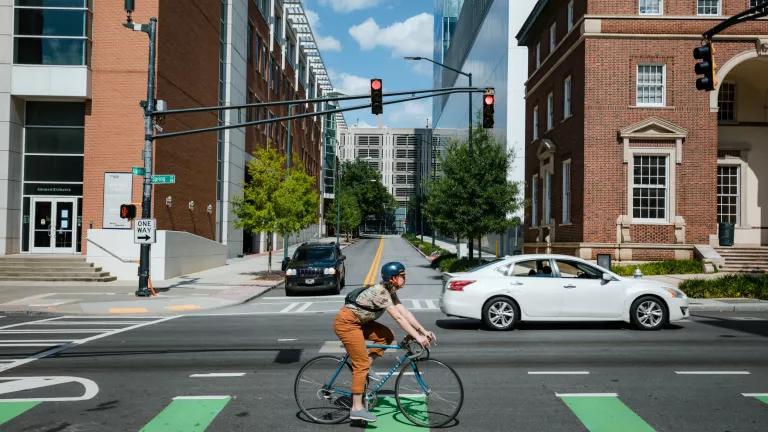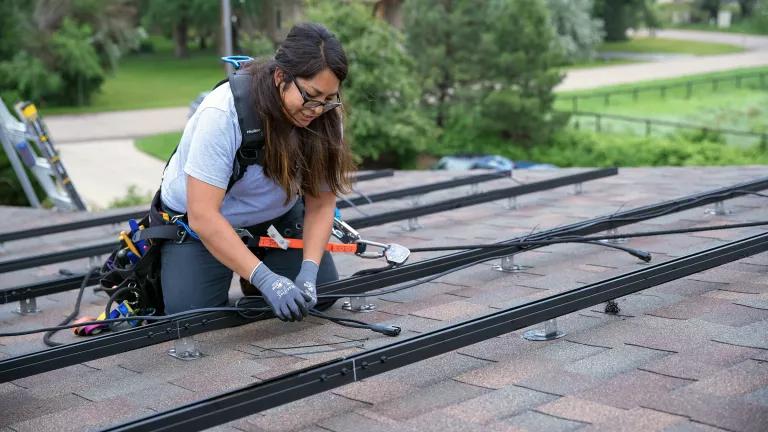Capturing stormwater using “green” practices such as trees, rain gardens, and porous pavement helps solve major urban stormwater problems while also improving the health and livability of neighborhoods.
As an increasing number of cities begin to implement green stormwater management practices on a large scale, the public-right-of-way is the first place these cities are looking to locate green practices. It makes sense that cities would look first to “green” in public places. Cities can easily maintain practices that are publicly owned and operated. The public is educated by the green roof on city hall, and the public enjoys the previously paved street median now bursting with drought-tolerant plants. However, research and analysis by the Natural Infrastructure Finance Laboratory, in which NRDC is a partner, indicates that cities have good reason to encourage private parcel owners to green on their own property. While cost data can range widely across cities, there may be substantial low-cost green infrastructure opportunities on private parcels.
Of course, it is very challenging to convince busy, cost-constrained commercial property owners to replace their driveways with porous pavement or to create rainwater catchment areas in their parking lots. Even if property owners did want to implement a green infrastructure retrofit, many would need financing for the project, all would require very quick project paybacks and all would want to avoid inconveniencing their tenants.
Creative municipal policies (like re-development requirements or stormwater fee discounts) can help make the business case to commercial owners. Although we at NRDC know that those are important strategies, we are the first to admit that they are only part of the answer; those policies will not alone catalyze a flood of greening projects in the near term.
In addition to creative municipal policies, building owners need to be able to weigh the costs and benefits of implementing green infrastructure on their property, similar to the analysis they would conduct to weigh established improvements such as new elevators or lobby improvements, seismic or energy-efficiency retrofits.
In short, building owners need more information about the benefits green infrastructure can bring to their bottom line. A new NRDC report, The Green Edge, is a crucial step in that direction. Drawing from nearly all available published material available on the topic, the new report cites examples of how green infrastructure can help property owners attract tenants and as a result charge higher rents, how green infrastructure can help increase property value, increase retail sales, and reduce energy bills, to name a few…
Crucially, the Green Edge also goes in-depth in a handful of cases to demonstrate the potential value to owners (and tenants) of a set of hypothetical green infrastructure retrofits in medium-sized office buildings, midrise apartment buildings and retail centers. In both the office building and apartment building examples, the total present value of benefits approaches $2 million; for the retail center, benefits exceed $24 million, including nearly $23 million of increased retail sales for tenants.
Green infrastructure can benefit cities in managing stormwater, it can benefit the public by regulating temperatures and cleaning the air, and now, with the Green Edge we have a first-of-its-kind report that collects all available information on how green infrastructure can directly benefit private property owners. While more quantitative data is needed on the costs and benefits of green infrastructure, it seems a virtual certainty that green infrastructure will follow in the footsteps of renewable energy and energy-efficiency retrofits: currently it is a novelty, followed by a period where it will become standard for industry leaders, and, in a few more years, it will become mainstream and standard practice for all commercial developers.
We may be a few years away from the ideal level of green infrastructure, but we hope the new NRDC report can start some conversations and shed new light on the tangible and monetizable ways that green infrastructure can benefit property owners.



